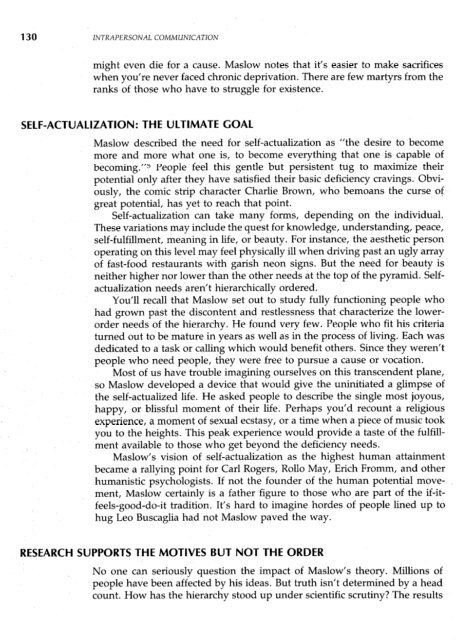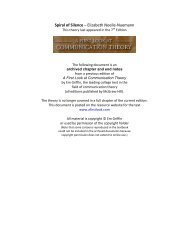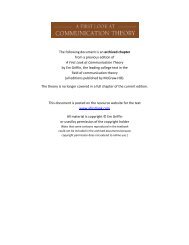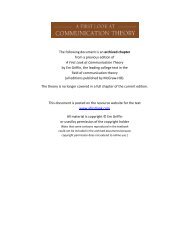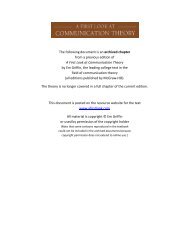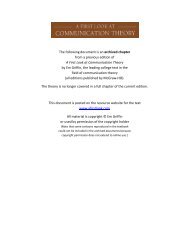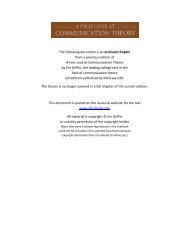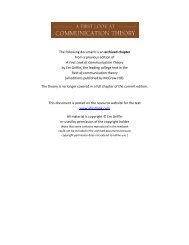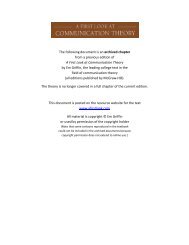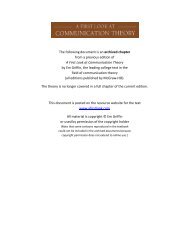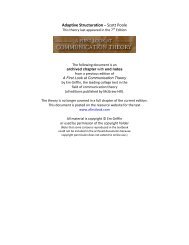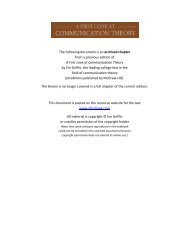Hierarchy of Needs (PDF) - A First Look at Communication Theory
Hierarchy of Needs (PDF) - A First Look at Communication Theory
Hierarchy of Needs (PDF) - A First Look at Communication Theory
Create successful ePaper yourself
Turn your PDF publications into a flip-book with our unique Google optimized e-Paper software.
130 LNTRAPERSONAL COMMUNlCATlONmight even die for a cause. Maslow notes th<strong>at</strong> it’s easier to make sacrificeswhen you’re never faced chronic depriv<strong>at</strong>ion. There are few martyrs from theranks <strong>of</strong> those who have to struggle for existence.SELF-ACTUALIZATION: THE ULTIMATE GOALMaslow described the need for self-actualiz<strong>at</strong>ion as “the desire to becomemore and more wh<strong>at</strong> one is, to become everything th<strong>at</strong> one is capable <strong>of</strong>becoming”5 People feel this gentle but persistent tug to maximize theirpotential only after they have s<strong>at</strong>isfied their basic deficiency cravings. Obviously,the comic strip character Charlie Brown, who bemoans the curse <strong>of</strong>gre<strong>at</strong> potential, has yet to reach th<strong>at</strong> point.Self-actualiz<strong>at</strong>ion can take many forms, depending on the individual.These vari<strong>at</strong>ions may include the quest for knowledge, understanding, peace,self-fulfillment, meaning in life, or beauty. For instance, the aesthetic personoper<strong>at</strong>ing on this level may feel physically ill when driving past an ugly array<strong>of</strong> fast-food restaurants with garish neon signs. But the need for beauty isneither higher nor lower than the other needs <strong>at</strong> the top <strong>of</strong> the pyramid. Selfactualiz<strong>at</strong>ionneeds aren’t hierarchically ordered.You’ll recall th<strong>at</strong> Maslow set out to study fully functioning people whohad grown past the discontent and restlessness th<strong>at</strong> characterize the lowerorderneeds <strong>of</strong> the hierarchy. He found very few. People who fit his criteri<strong>at</strong>urned out to be m<strong>at</strong>ure in years as well as in the process <strong>of</strong> living. Each wasdedic<strong>at</strong>ed to a task or calling which would benefit others. Since they weren’tpeople who need people, they were free to pursue a cause or voc<strong>at</strong>ion.Most <strong>of</strong> us have trouble imagining ourselves on this transcendent plane,so Maslow developed a device th<strong>at</strong> would give the uniniti<strong>at</strong>ed a glimpse <strong>of</strong>the self-actualized life. He asked people to describe the single most joyous,happy, or blissful moment <strong>of</strong> their life. Perhaps you’d recount a religiousexperience, a moment <strong>of</strong> sexual ecstasy, or a time when a piece <strong>of</strong> music tookyou to the heights. This peak experience would provide a taste <strong>of</strong> the fulfillmentavailable to those who get beyond the deficiency needs.Maslow’s vision <strong>of</strong> self-actualiz<strong>at</strong>ion as the highest human <strong>at</strong>tainmentbecame a rallying point for Carl Rogers, Rollo May, Erich Fromm, and otherhumanistic psychologists. If not the founder <strong>of</strong> the human potential movement,Maslow certainly is a f<strong>at</strong>her figure to those who are part <strong>of</strong> the if-itfeels-good-do-ittradition. It’s hard to imagine hordes <strong>of</strong> people lined up tohug Leo Buscaglia had not Maslow paved the way.RESEARCH SUPPORTS THE MOTIVES BUT NOT THE ORDERNo one can seriously question the impact <strong>of</strong> Maslow’s theory. Millions <strong>of</strong>people have been affected by his ideas. But truth isn’t determined by a headcount. How has the hierarchy stood up under scientific scrutiny? The results


